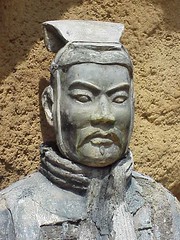
Scientists have been examining pollen in China's terracotta warriors in a bid to find out where they were made.
Researchers from the Chinese Academy of Sciences in Beijing discovered that the warriors and horses that form the Terracotta Army contain different pollen signatures.
The soldier figures appear to have been fired at kilns located a significant distance from the Chinese Emperor's tomb they were designed to guard, while the heavier horses seem to have been created locally as they are more fragile and could have been damaged by transportation.
Experts hope that the research will enable them to pinpoint the locations of the kilns used to make the famous statues of warriors, horses and chariots. It marks the first time that pollen samples have been recovered from pottery and used for analysis in this way.
More than 2,200 years old, the Terracotta Army comprises 8,000 soldiers, 300 horses and 200 chariots and was unearthed in the tomb of China's first emperor, Qin Shihuang, in 1974.
No comments:
Post a Comment